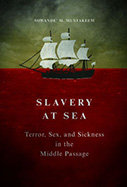SLAVERY AT SEA: TERROR, SEX, AND SICKNESS IN THE MIDDLE PASSAGE

Author: Sowande’ M. Mustakeem
Publisher: Urbana, IL: University of Illinois Press, 2016. 288p.
Reviewer: Kenneth Morgan | October 2017
To write a book on the Middle Passage, the forced migration of enslaved Africans across the Atlantic to the Americas, is not to enter virgin territory. From the abolitionist campaigners against the slave trade in late eighteenth-century Britain, to modern academic books and to information gathered by supporters for reparations regarding slavery, thousands of pages of evidence and analyses on the Middle Passage are available both for specialists and the educated public to read and ponder. Some academic studies are concerned primarily with the numbers and quantitative flow of the enslaved during the Middle Passage. This approach can now be carried out comprehensively with the statistics assembled for the freely available Trans-Atlantic Slave Trade Database (www.slavevoyages.org). Other interpretations of the Middle Passage concentrate more on the human misery involved in the shipment of Africans across the ocean. They draw on a plethora of testimonies by participants in the slave trade – ship captains, merchants, agents along the west African coast – and on information gathered by British parliamentary committees. The best studies of the Middle Passage combine both quantitative and qualitative materials, avoiding the charges, on the one hand, that they deal with the suffering of millions of people as if they were an historical abstraction and, on the other, that they cite emotive material that cannot always be claimed to have been typical of the trade.
Sowande’ Mustakeem’s book is emphatically within the qualitative tradition. Though figures are sometimes inserted into her text, Slavery at Sea primarily uses descriptive material researched from a wide range of sources. The purpose of the book is to show that many elements of slavery, notably the abusive treatment of Africans, can be fully traced in the gathering of the enslaved in Africa, their treatment aboard ship, and their sale. Thus, there is detailed consideration of the capture of slaves in Africa, their treatment along the west African coast and on the Middle Passage, their health conditions and psychological suffering, and their mortality. Stealing away Africans from their home communities lies at the heart of enslavement. Familial separations are highlighted to expose the cruelty of the processes involved in securing slaves and transporting them to the Americas. The capture of slaves in Africa was often a long-drawn-out process in which captives were exchanged several times before they reached the slave ships. This initiated a cycle of separation among people of different African backgrounds and ethnicities that continued throughout the Middle Passage and sale process in the Americas.
Matters concerning the age and gender of slaves are discussed extensively in Slavery at Sea. Mustakeem confirms historians’ consensus that male slaves outnumbered female captives. This was partly because of planter demand in North America and the Caribbean for healthy, young adult male workers. But it also occurred because many African societies, needing female reproductive and working capacities, were reluctant to release adult women into the slave trade. Mustakeem is particularly good at showing the many violations by traders of the bodies of the enslaved, quoting liberally from primary sources that state explicitly how adult female slaves attracted the unwanted attention of traders who pressed their flesh, fondled their breasts, and raped them. There is fuller attention in the book than in any other academic study of the Middle Passage to the disposal of unwanted slaves, both before loading ships in west Africa and after the sale process in the New World. The sick, the elderly, the lame and the blind could all be found among cargoes of slaves, but they were of little use for capitalists seeking profits. Mustakeem claims that a good many of these “refuse” slaves were killed, either in west Africa or in the Americas, because of their unfitness for sale, but the sources cited give no indication about how extensive this practice was.
The blurb on the back of Slavery at Sea claims that it is a “groundbreaking study” of “the world’s most commercially sought commodity for over four centuries.” This is an overstatement. Concentrating on the British slave trade, Mustakeem draws upon primary sources that have already been used on the Middle Passage in books such as Marcus Rediker’s The Slave Ship: A Human History (2007) and Alexander X. Byrd’s Captives and Voyagers: Black Migrants across the Eighteenth-Century British Atlantic World (2008). Mustakeem uses many of the same sources effectively in Slavery at Sea, but neglects other primary material that would have deepened her analysis. Thus, the accounts of Ottobah Cugoano and Olaudah Equiano are used for first-hand experience of the process of enslavement and the Middle Passage, but not the memoirs of Boyrereau Brinch, the blind African slave. First-hand information from slave ship captains and merchants reported in the House of Commons Sessional Papers is mined extensively, but associated, equally illuminating, material in the House of Lords Sessional Papers is ignored.
In addition, important aspects of the Middle Passage, its background and its immediate impact in the Americas, are omitted from Slavery at Sea. The variety in the means of enslavement in the seven west African regions from which Britain gathered slaves is not discussed. Abundant material exists to explain how, for example, the gathering of slaves by canoes along the rivers of the Bight of Biafra and bartering at inland fairs differed from the maintenance of slaves in compounds on offshore islands near Sierra Leone. Comparisons between crew and slave mortality on the Middle Passage would have enhanced the discussion in chapter 6 of the suffering and mortality of African captives on board ship by showing how crews also faced disease and death in significant numbers. The analysis in chapter 7 of slave sales in North America and the Caribbean would have benefited from additional sections on the sales of slaves by lot, and on the seasoning process that shaped the slaves for plantation work.
Two further reservations require noting. First, there is some tilting at windmills. “The mixture of bondwomen across lines of age and circumstance of motherhood,” the author claims, “debunks previously held ideas that females on slave ships solely comprised adult women” (pp. 41-2). No reputable source on the Middle Passage claims this, however, and the qualitative material cited by Mustakeem cannot prove anything about trends in the ages of female slaves on board ships. Such material could easily have been assembled and incorporated into the book from estimates in the Transatlantic Slave Trade Database, referred to above, but the author has not undertaken that task. Second, Slavery at Sea is fully referenced with one significant exception: all references to merchants’ letters only give the generic name of the manuscript collection and not the writers and recipients of letters, the date when the letter was written, and the archival citation. This disinclination to cite manuscripts precisely is unhelpful to other scholars, especially as some of the sources referred to in British and New England archives are extensive.
Despite these qualifications, it would be unfair to the author to be too carping. Slavery at Sea is a welcome book because it provides a more sustained account of the deprivations and indignities inflicted upon enslaved Africans by European capitalists and their collaborators in Africa – some black, some white, some mixed race – than virtually any other book. The terrors of the slave trade for the victims are laid bare, with an intelligent selection of quotations from the primary source material to underscore the violence of this traffic in human beings. Mustakeem has a keen eye for quotations that unequivocally highlight the aggressive and often savage way in which enslaved Africans were passed through the hands of captors. This makes for grim reading, but that is the reality of the Middle Passage. Previous historians, such as Rediker, have exposed the cruelty inflicted on Africans by quoting from the written remarks made by slave ship captains, but no-one has set this down as unflinchingly as Mustakeem. Supporters of reparations for slavery and the slave trade will no doubt find the book to be a goldmine of information to support their cause.
Slavery at Sea will be very useful for teaching undergraduates about this cruel commerce. One could set this book for seminar reading for students who have no knowledge of the Middle Passage and they would come away well informed about the topic. Professional historians will also learn much from this analysis of the commodification of Africans for life on the plantations, though they might wish that the author had included a fuller quantitative dimension to her discussion. Whether one can describe the Middle Passage as slavery at sea can be debated; some might consider that the more traditional view of the Atlantic crossing as a prelude to slavery is more appropriate for the subject matter. Nevertheless, there is no doubt, as this book shows, that captives were adapted on a daily basis to their future life as slaves through their treatment on the Atlantic crossing, and that the passing of Africans through a chain of human beings involved in making a profit from their shipment and sale was a relentless, well-coordinated process.
Kenneth Morgan, Professor of History, Department of Politics, History & Law, Brunel University London


